The Study on the Performance Evaluation of Spatial Governance of Village and Town Business Communities
Abstract
:1. Introduction
2. Literature Review
2.1. Government Behavior
2.2. Performance Management
2.3. The Governance of Village and Town Communities
- (1)
- It is found from the research content that, the field of construction planning of village and town communities is the only focus in the existing literature. The studies on spatial governance of village and town communities are less involved, and a unified evaluation index system of spatial governance performance has not come into being. The governance content and scope of village and town communities are very extensive. Therefore, when the research of the evaluation index system is carried out, a reasonable and comprehensive selection of social, economic, and political indexes is necessary. Through scientific methods, they need to be quantified and their weights need to be determined, thus an accurate assessment is made of the spatial governance performance of village and town business communities.
- (2)
- In terms of the research methodology, the standard definition and theoretical framework of village and town business communities have not been clarified in the academic world. There is no clear comprehensive performance evaluation approach for their spatial governance. It is necessary to further consider China’s special national realities and real situations of its local villages and towns. Evaluation methods including hierarchical analysis, principal component analysis, gray correlation method, data envelopment analysis are used in a scientific and reasonable manner to make sure these methods “adapt to local conditions” and “adapt to time”.
3. Model Framework
3.1. IELHG-PSR Diamond Model of Spatial Governance
3.2. Methodological Framework for the Performance Evaluation of Spatial Governance
4. The Spatial Governance Evaluation System for Village and Town Business Communities
4.1. Sample and Data
4.2. Elements of the Evaluation System
4.3. Index Screening for Evaluation System
4.4. Determination of Index Weights
4.5. Rating of Spatial Governance Performance of Village and Town Business Communities
5. Result
5.1. Presentation of Evaluated Scores in Spatial Governance Factors
5.2. Variance Analysis for Five-Dimensional System of Spatial Governance
5.3. Classification of Spatial Governance Performance Echelons
- (1)
- Governments of higher levels tend to pay more attention, and favorable policies tend to be issued.
- (2)
- The difference in their own development directions and governance model transformations.
- (3)
- Adequacy of the utilization of local advantageous elements and capital introduction.
5.4. Comparison of Community Types of Spatial Governance Performance
5.5. Analysis of Coordination Index for Spatial Governance Performance
5.6. Goal Setting in Spatial Governance Based on Performance Indexes
6. Conclusions and Implications
6.1. Conclusions
- (1)
- A theoretical background is provided for the spatial governance of village and town business communities via the definition of the concepts of sustainability theory, village and town business communities, and spatial governance performance, as well as sorting-out of governmental behavior theory and performance management theory. Further, the development forms and characteristics are classified based on the industrial and economic radiation drive of the inner and outer edge, and four major types are formed: the economic radiation-driven type of central towns in the county, the characteristic-driven agricultural specialized production, the comprehensive development of township industry, and the tourism industry driving type of scenic village. Finally, based on the above theories, the basic concepts, which are involved in the spatial governance performance assessment of village and town business communities, are defined. The essence, objectives, and characteristics of spatial governance of village and town business communities are proposed, and the meaning of performance assessment in this study is elaborated. A preliminary theoretical construction is realized for spatial governance performance assessment of village and town business communities.
- (2)
- The PSR pressure–state–response model is adopted, based on the objectives of “five beauties” (industrial beauty, ecological beauty, cultural beauty, life beauty, and innovative beauty) in “Construction of Guidelines for Beautiful Towns” to form the IELHG-PSR diamond model of spatial governance, and an assessment index system on the basis of five dimensions: industrial upgrading, environmental renovation, life quality, humanistic characteristics, and governance of society. The Delphi method is used to delete the indexes, and the system finally covers five primary indexes, fourteen secondary indexes, and thirty-six tertiary indexes; the analytic hierarchy process and YAAHP10.1 software are used to test the established index system for consistency and to determine the weights.
- (3)
- The constructed sustainable spatial governance performance evaluation system is applied to village and town business communities. Samples of 12 village and town business communities in Anji County are selected. Field research, expert consultation, questionnaire survey, and multiple comparisons are conducted, and the evaluation indexes are finally determined to be measured by a unified and balanced assignment method. Each index is divided into five levels I, II, III, IV, and V according to different criteria. Each level is assigned with 100, 80, 60, 40, and 20 points for index quantification. The results show that Xilong, Xiaoshu, and Jingwan gain the highest comprehensive scores in spatial governance in the first echelon, while Baofu and Shanchuan are in the second echelon; Zhangwu and Guishanchang are in the third echelon, and all other remaining villages and towns are in the fourth echelon. In terms of subtypes, the comprehensive scores for the tourism industry driving type of scenic village and the characteristic-driven agricultural specialized production are generally high, while that for the comprehensive development of township industry and the economic radiation-driven type of central towns in the county are slightly lower. The IELHG-PSR model is used to draw radar charts to evaluate the scores of the five-dimensional systems of the 12 village and town business communities and the strengths and weaknesses of spatial governance of each village and town community. The coordination function is used to evaluate the development relationship among the PSR subsystems of the 12 sample communities. It is found that Port, Zhangwu, and Gaoyu boast the highest coordination, while Xiaoshu, Xilong, and Baofu have lower coordination. It is proposed that in the spatial governance of village and town business communities, attention should be paid to the reasonable control of investment and construction volume, precise classification, step-by-step promotion, and avoidance of blind investment; the response level of spatial governance should be slowly kept in line with the pressure and state levels to guarantee their balanced development, and meet the new requirements of sustainable development for the coordination status of spatial governance systems.
6.2. Contributions
- (1)
- Theoretical contributions
- (2)
- Practical implications
6.3. Limitations and Future Research
- (1)
- The contents and objects of spatial governance of village and town business communities are complicated, and there are many relevant policy documents issued at the national, provincial, and municipal levels. The research on this issue involves different disciplines such as political science, sociology, management, and human geography. In the article, general theoretical analyses and abstract generalizations are made mainly from the disciplinary perspectives of architecture and planning, but there is a lack of microscopic and detailed explanations of specific governmental decision-making and administrative implementation. So, it is difficult to present how the government prevents and resolves the risks and crises occurring in urbanization in spatial governance and to resolve the contradictions and conflicts among multiple spatial interest groups in spatial governance. Here, the analysis of the governance revolution of village and town business communities is just made roughly.
- (2)
- The spatial governance of village and town business communities represents a specific practical process, and the governance methods and changes in spatial forms will all be different in different cities. In the study, the analysis is made based on the empirical data from field interviews and 12 typical cases about the spatial governance of village and town business communities in Anji County. The samples are not sufficiently selected and there is a certain subjectivity, so there are differences in the applicability of the strategic guidelines, and these differences need to be solved according to the local realities.
- (3)
- There is a lack of studies based on individual buildings. Because this study belongs to a cross-disciplinary scope, theoretical knowledge of architecture and management is used to analyze village and town business communities and community groups as the main research objects. The plane spatial locations are set in terms of the spatial governance input density, and supplements and improvements can be made in subsequent studies from the perspective of GEP (gross ecosystem product) and green buildings.
Author Contributions
Funding
Institutional Review Board Statement
Informed Consent Statement
Acknowledgments
Conflicts of Interest
References
- Schprya, A. Can Asia lead Power Ambitions and Global Governance in the Twenty- first Century. Int. Aff. 2011, 87, 851–869. [Google Scholar]
- Niclds, R. Why Measure Performance? Different Purposes Require Different Measures. Public Adm. Rev. 2003, 63, 13–22. [Google Scholar]
- Schneier, W. Governing Methods: Policy Innovation Labs, Design and Data Science in the Digital Governance of Education. J. Educ. Adm. Hist. 2015, 43, 251–271. [Google Scholar]
- Richard, W. Professionalizing business district management for the twenty-first century. J. Place Manag. Dev. 2008, 1, 102–109. [Google Scholar]
- Goodwin, M. The governance of rural areas: Some emerging research issues and agendas. J. Rural Stud. 1998, 14, 5–12. [Google Scholar] [CrossRef]
- Murdoch, J.; Abram, S. Defining the limits of community governance. J. Rural Stud. 1998, 14, 41–50. [Google Scholar] [CrossRef]
- Edwards, B.; Goodwin, M.; Pemberton, S.; Woods, M. Partnerships, Power, and Scale in Rural Governance. Environ. Plan. C Gov. Policy 2016, 19, 289–310. [Google Scholar] [CrossRef]
- Marsden, T. New rural territories: Regulating the differentiated rural spaces. J. Rural Stud. 1998, 14, 107–117. [Google Scholar] [CrossRef]
- Bhagat, R.B. Rural-urban classification and municipal governance in India. Singap. J. Trop. Geogr. 2005, 26, 61–73. [Google Scholar] [CrossRef]
- Scott, A.J.; Carter, C.; Reed, M.R.; Larkham, P.; Adams, D.; Morton, N.; Coles, R.; Waters, R.; Collier, D.; Crean, C.; et al. Disintegrated development at the rural–urban fringe: Re-connecting spatial planning theory and practice. Prog. Plan. 2013, 83, 1–52. [Google Scholar] [CrossRef] [Green Version]
- Pemberton, S.; Shaw, D. New Forms of Sub-regional Governance and Implications for Rural Areas: Evidence from England. Plan. Pract. Res. 2012, 27, 441–458. [Google Scholar] [CrossRef]
- Valentinov, V. Explaining the Rise of Rural Governance in Europe. Eur. Plan. Stud. 2008, 16, 1161–1165. [Google Scholar] [CrossRef]
- Castro-Arce, K.; Vanclay, F. Transformative social innovation for sustainable rural development: An analytical framework to assist community-based initiatives. J. Rural Stud. 2020, 74, 45–54. [Google Scholar] [CrossRef]
- Georgios, C.; Barraí, H. Social innovation in rural governance: A comparative case study across the marginalised rural EU. J. Rural Stud. 2021. [Google Scholar] [CrossRef]
- Georgios, C.; Nikolaos, N.; Michalis, P. Neo-Endogenous Rural Development: A Path toward Reviving Rural Europe. Rural. Sociol. 2021, 86, 911–937. [Google Scholar] [CrossRef]
- Furmankiewicz, M.; Janc, K.; Macken-Walsh, Á. The impact of EU governance and rural development policy on the development of the third sector in rural Poland: A nation-wide analysis. J. Rural Stud. 2016, 43, 225–234. [Google Scholar] [CrossRef]
- O’Toole, K.; Burdess, N. New community governance in small rural towns: The Australian experience. J. Rural Stud. 2004, 20, 433–443. [Google Scholar] [CrossRef]
- Dinnie, E.; Fischer, A. The Trouble with Community: How ‘Sense of Community’ Influences Participation in Formal, Community-Led Organisations and Rural Governance. Sociologia Ruralis 2019, 60, 243–259. [Google Scholar] [CrossRef]
- Brown, D.L.; Shucksmith, M. Reconsidering Territorial Governance to Account for Enhanced Rural-Urban Interdependence in America. ANNALS Am. Acad. Political Soc. Sci. 2017, 672, 282–301. [Google Scholar] [CrossRef]
- Balazs, I.; Hoffman, I. Can (re) centralization be a modern governance in rural areas? Transylv. Rev. Adm. Sci. 2017, 13, 5–20. [Google Scholar] [CrossRef] [Green Version]
- Marquard, E.; Bartke, S.; Gifreu i Font, J.; Humer, A.; Jonkman, A.; Jürgenson, E.; Marot, N.; Poelmans, L.; Repe, B.; Rybski, R.; et al. Land Consumption and Land Take: Enhancing Conceptual Clarity for Evaluating Spatial Governance in the EU Context. Sustainability 2020, 12, 8269. [Google Scholar] [CrossRef]
- Salman Khan, M.; Syrett, S. An institutional analysis of ‘power within’ local governance: A Bazaari tale from Pakistan. World Dev. 2022, 154, 105882. [Google Scholar] [CrossRef]
- Scott, M. Building institutional capacity in rural Northern Ireland: The role of partnership governance in the LEADER II programme. J. Rural Stud. 2004, 20, 49–59. [Google Scholar] [CrossRef]
- Furmankiewicz, M.; Macken-Walsh, Á. Government within governance? Polish rural development partnerships through the lens of functional representation. J. Rural Stud. 2016, 46, 12–22. [Google Scholar] [CrossRef]
- Allmendinger, P.; Haughton, G. The Evolution and Trajectories of English Spatial Governance: ‘Neoliberal’ Episodes in Planning. Plan. Pract. Res. 2013, 28, 6–26. [Google Scholar] [CrossRef]
- Beer, A. Leadership and the governance of rural communities. J. Rural Stud. 2014, 34, 254–262. [Google Scholar] [CrossRef]
- Ge, D.; Lu, Y. A strategy of the rural governance for territorial spatial planning in China. J. Geogr. Sci. 2021, 31, 1349–1364. [Google Scholar] [CrossRef]
- Brunori, G.; Rossi, A. Differentiating countryside: Social representations and governance patterns in rural areas with high social density: The case of Chianti, Italy. J. Rural Stud. 2007, 23, 183–205. [Google Scholar] [CrossRef]
- Dressler, W.; Roth, R. The Good, the Bad, and the Contradictory: Neoliberal Conservation Governance in Rural Southeast Asia. World Dev. 2011, 39, 851–862. [Google Scholar] [CrossRef]
- Koopmans, M.E.; Rogge, E.; Mettepenningen, E.; Knickel, K.; Šūmane, S. The role of multi-actor governance in aligning farm modernization and sustainable rural development. J. Rural Stud. 2018, 59, 252–262. [Google Scholar] [CrossRef]
- Darban Astane, A.; Rezvani, M.R.; Motiee Langroodi, S.; Badri, S.A. Measurement and Analysis of Factors Affecting Rural Governance in Local Government (Case Study: Qazvin Township). Hum. Geogr. Res. 2010, 42, 99–118. [Google Scholar]
- Romeo, G.; Marcianò, C. Performance evaluation of rural governance using an integrated AHP-VIKOR methodology. In Agricultural Cooperative Management and Policy; Springer: Berlin, Germany, 2014; pp. 109–134. [Google Scholar]
- Ohta, R.; Ryu, Y.; Kataoka, D.; Sano, C. Effectiveness and Challenges in Local Self-Governance: Multifunctional Autonomy in Japan. Int. J. Environ. Res. Public Health 2021, 18, 574. [Google Scholar] [CrossRef] [PubMed]
- Rogers, E.M.; Raber, J.F. Changes in Rural Community; Wang, X.; Wang, D., Translators; Zhejiang People’s Publishing House: Zhejiang, China, 1988. [Google Scholar]
- Marsden, T.; Murdoch, J. The shifting nature of rural governance and community participation. J. Rural Stud. 1998, 1, 1–4. [Google Scholar] [CrossRef]
- Ye, Q. Study of Rural Construction in Developed Countries and Policy Research; Architecture & Building Press: Beijing, China, 2008. [Google Scholar]
- Ferdinand, T. Translated by Lin Rongyuan. Community and Society: The Basic Concepts of Pure Sociology; Peking University Press: Beijing, China, 2010. [Google Scholar]
- Torre, A.; Wallet, F. Innovation and Governance of Rural Territories, in Renewing Innovation Systems in Agriculture and Food; Springer: Berlin, Germany, 2013; pp. 147–164. [Google Scholar]
- Westerink-Petersen, J. Making A Difference: Boundary Management in Spatial Governance; Wageningen University and Research: Wageningen, The Netherlands, 2016. [Google Scholar]
- Agyemang, F.S.K.; Amedzro, K.K.; Silva, E. The emergence of city-regions and their implications for contemporary spatial governance: Evidence from Ghana. Cities 2017, 71, 70–79. [Google Scholar] [CrossRef] [Green Version]
- Sielker, F. European spatial governance–towards a sectoralisation of spatial planning. J. Prop. Plan. Environ. Law 2018, 10, 126–139. [Google Scholar] [CrossRef]
- Asher, S.; Nagpal, K.; Novosad, P. The Cost of Distance: Geography and Governance in Rural India; The University of Oxford: Oxford, UK, 2018. [Google Scholar]
- Ge, D.; Zhou, G.; Qiao, W.; Yang, M. Land use transition and rural spatial governance: Mechanism, framework and perspectives. J. Geogr. Sci. 2020, 30, 1325–1340. [Google Scholar] [CrossRef]
- Sun, P.; Zhou, L.; Ge, D.; Lu, X.; Sun, D.; Lu, M.; Qiao, W. How does spatial governance drive rural development in China’s farming areas? Habitat Int. 2021, 109, 102320. [Google Scholar] [CrossRef]
- Ma, X. An Empirical Study on the Performance Gap of Cultural Governance in the Process of Rural Revitalization--Based on the Survey Data of 60 Villages across China. J. Henan Norm. Univ. Ed. Philos. Soc. Sci. 2019, 46. [Google Scholar]
- Yilin, W. Research on Environmental Governance and Governance Performance of Beautiful Villages in Niudian Town, Xinmi City; Henan University of Economics and Law: Henan, China, 2021. [Google Scholar]
- Jieshun, Y.; Yiqing, C.; Shuqing, Y.; Feixiang, L. Construction and Measurement of Performance Evaluation Index System for Rural Gov-ernance--an Empirical Analysis based on 54 Sample Villages in Jinjiang City. J. Zaozhuang Univ. 2021, 38, 134–144. [Google Scholar]
- Driessen, P.P.; Dieperink, C.; Van Laerhoven, F.; Runhaar, H.A.; Vermeulen, W.J. Towards a Conceptual Framework for The Study of Shifts in Modes of Environmental Governance–Experiences From The Netherlands. Environ. Policy Gov. 2012, 22, 143–160. [Google Scholar] [CrossRef] [Green Version]
- Folke, C.; Hahn, T.; Olsson, P.; Norberg, J. Adaptive governance of social-ecological systems. Annu. Rev. Environ. Resour. 2005, 30, 441–473. [Google Scholar] [CrossRef] [Green Version]
- Oatley, N. Cities, Economic Competition and Urban Policy; Paul Chapman Publish Ltd.: London, UK, 1998; p. 30. [Google Scholar]
- Bovaird, T. Beyond engagement and participation:user and community coproduction of public services. Public Adm. Rev. 2007, 67, 846–860. [Google Scholar] [CrossRef]
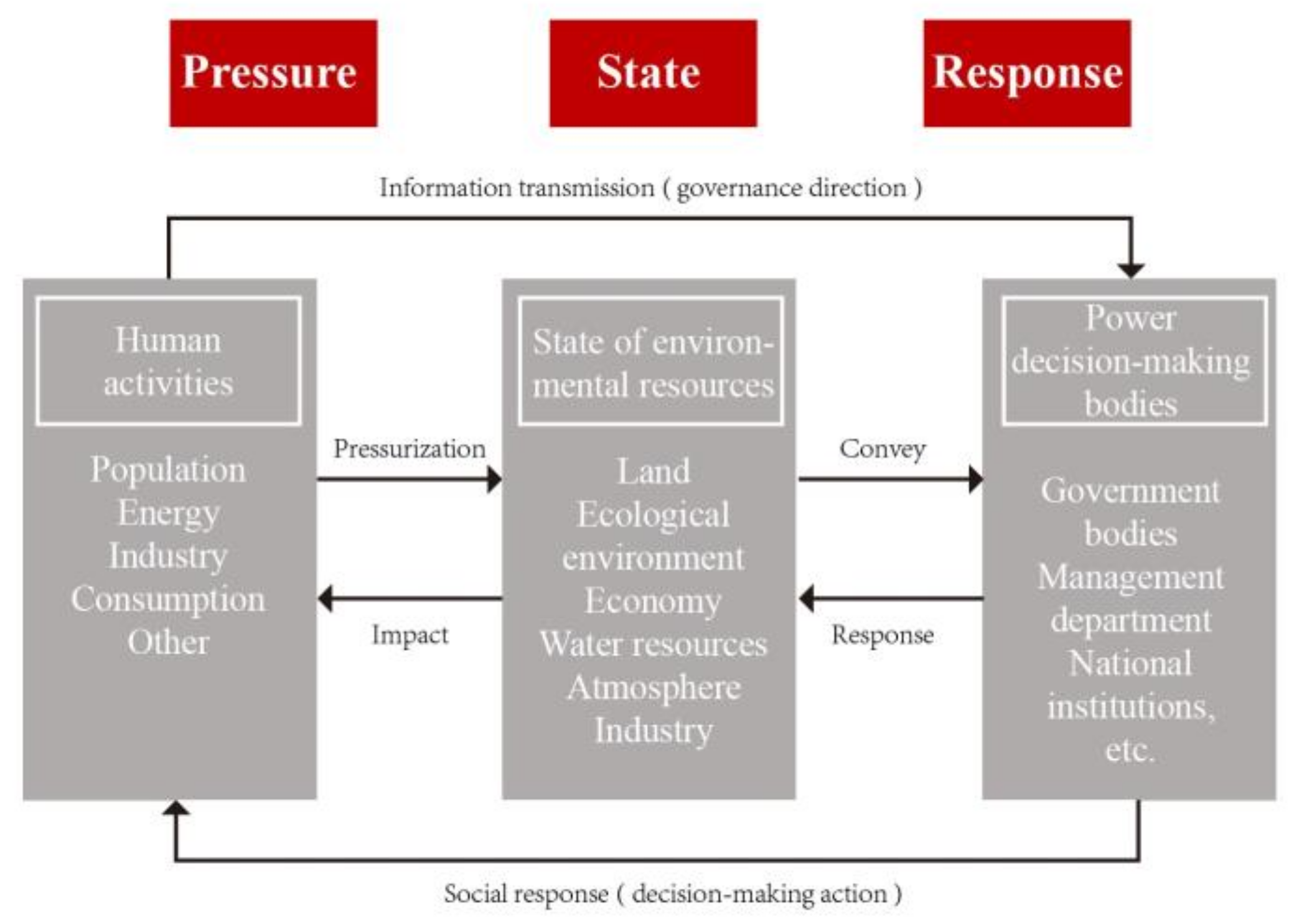
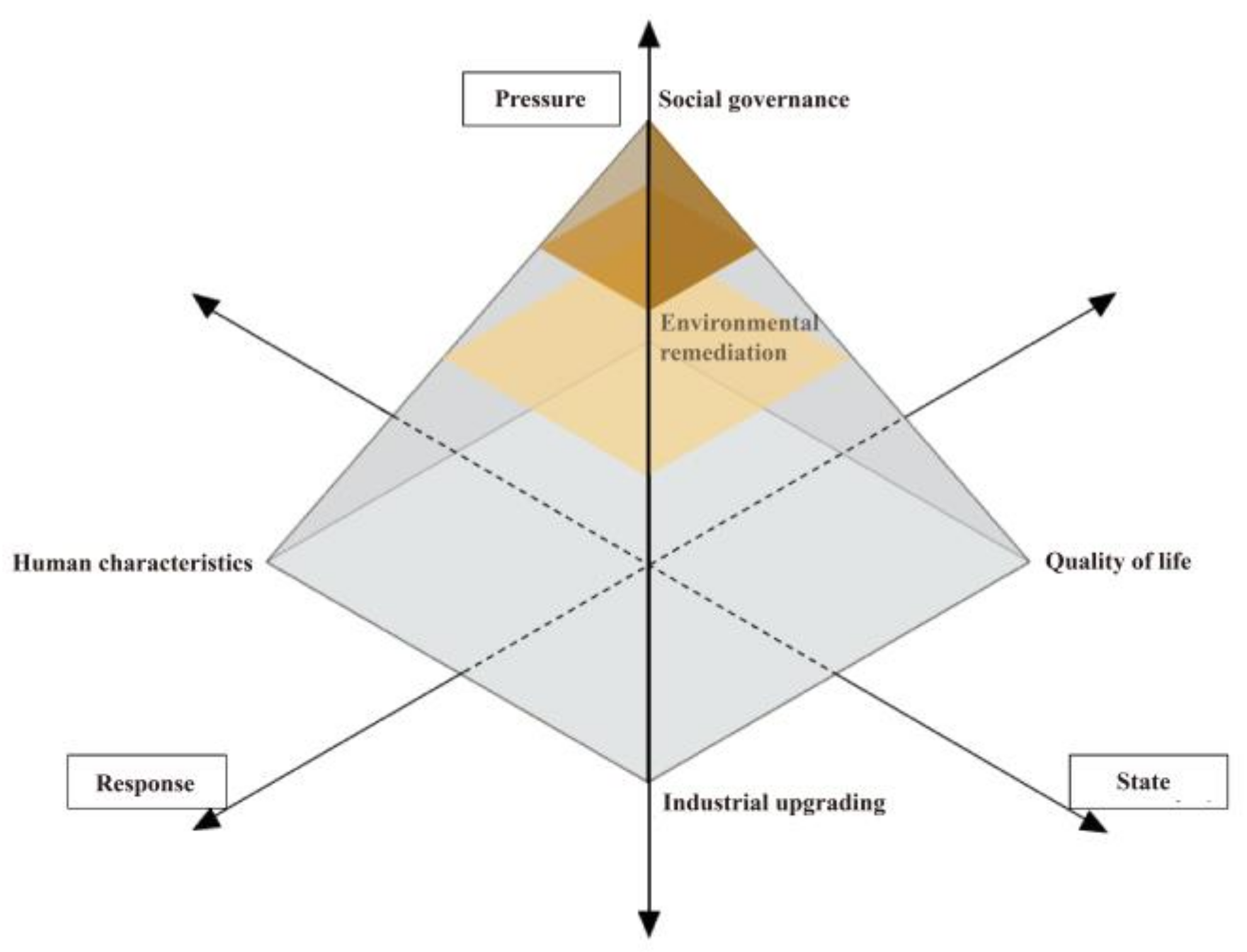

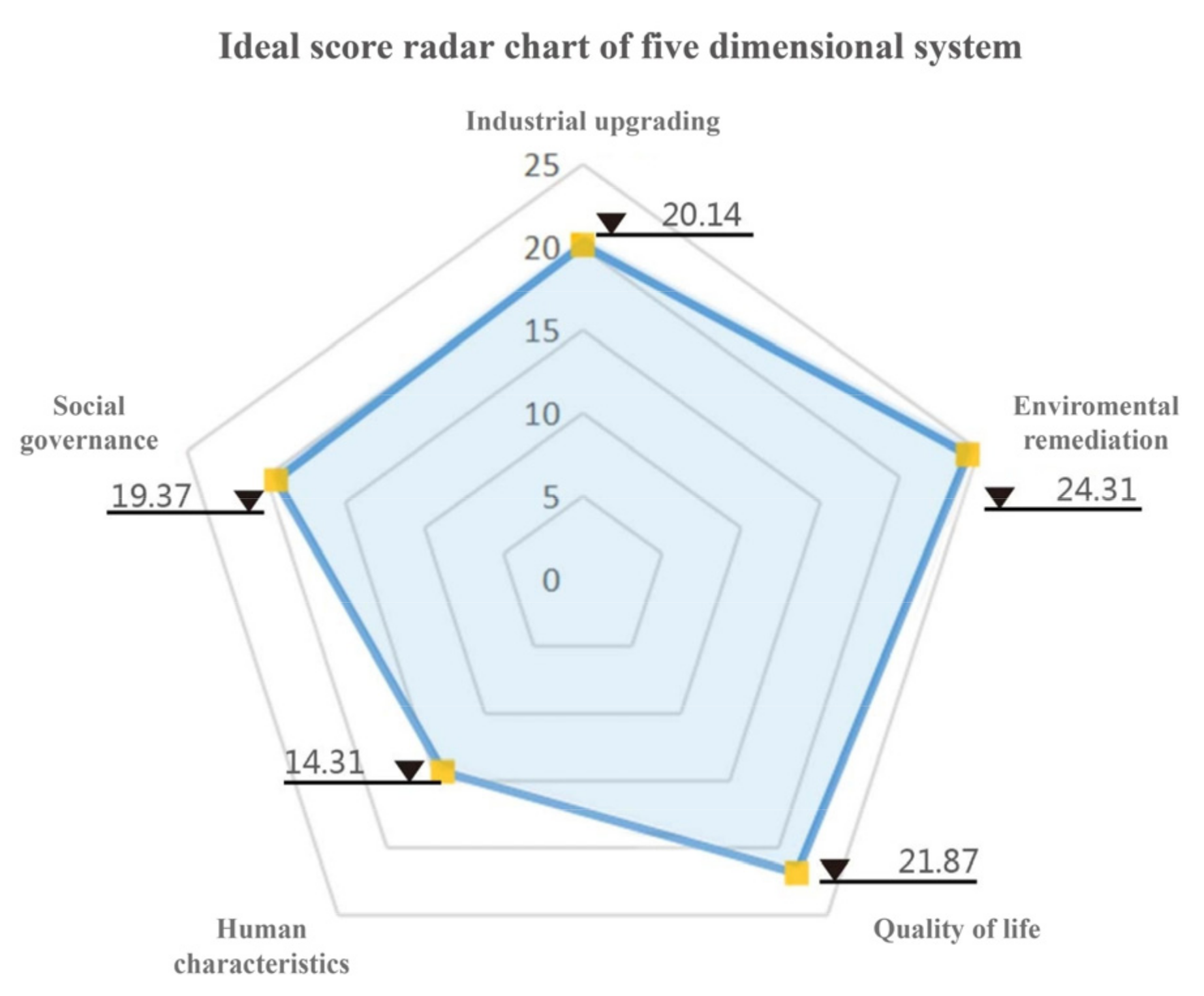
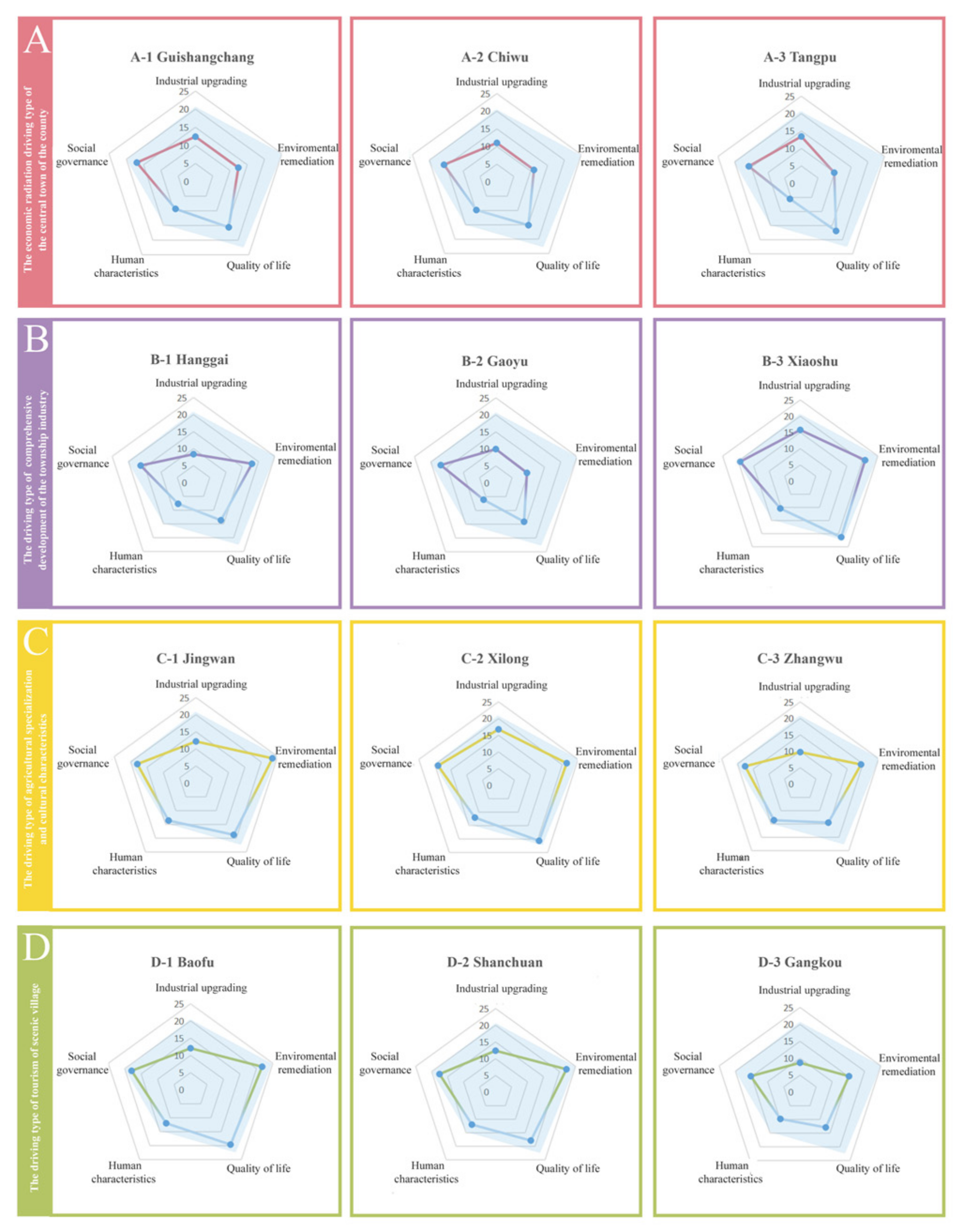
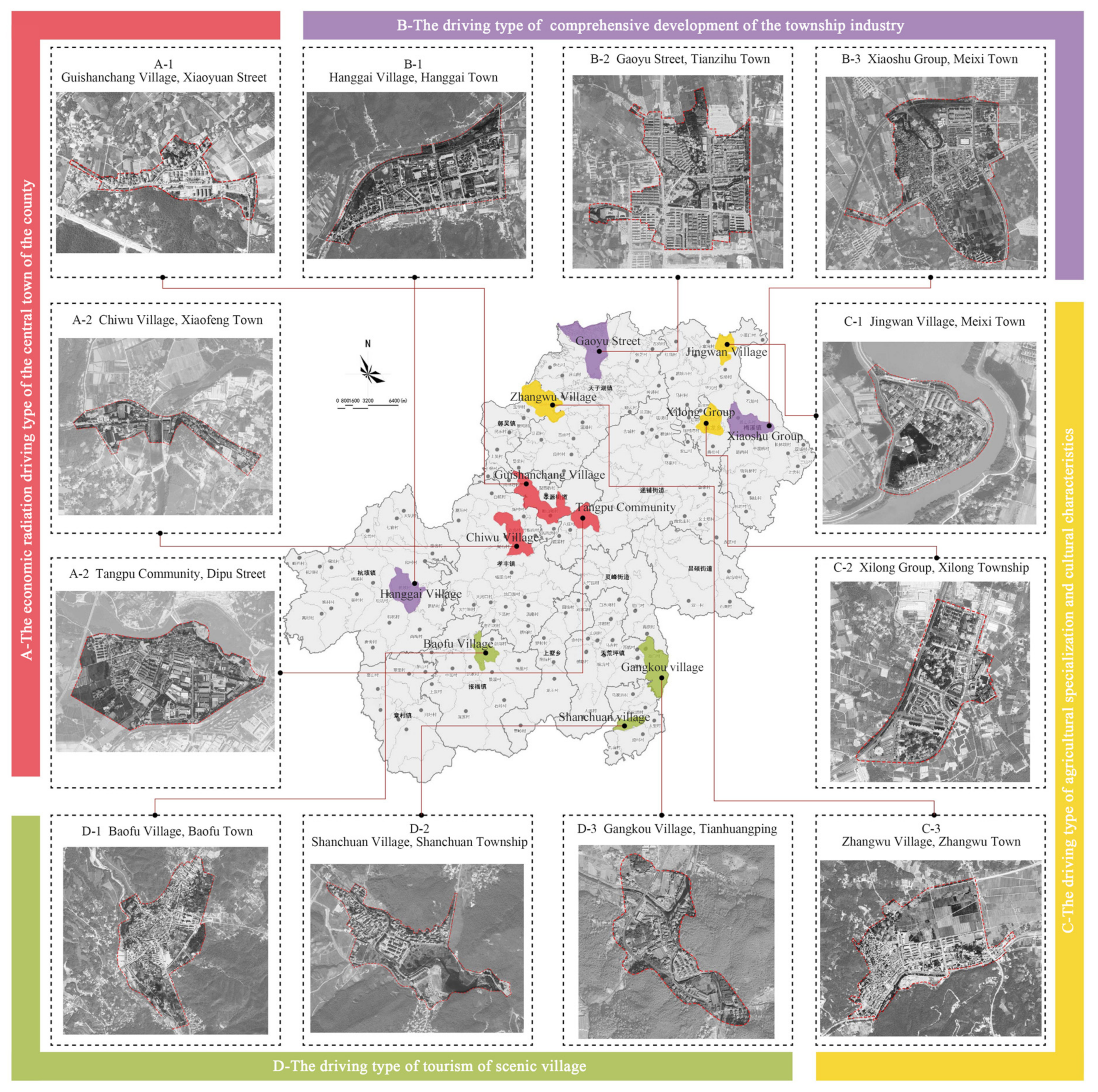
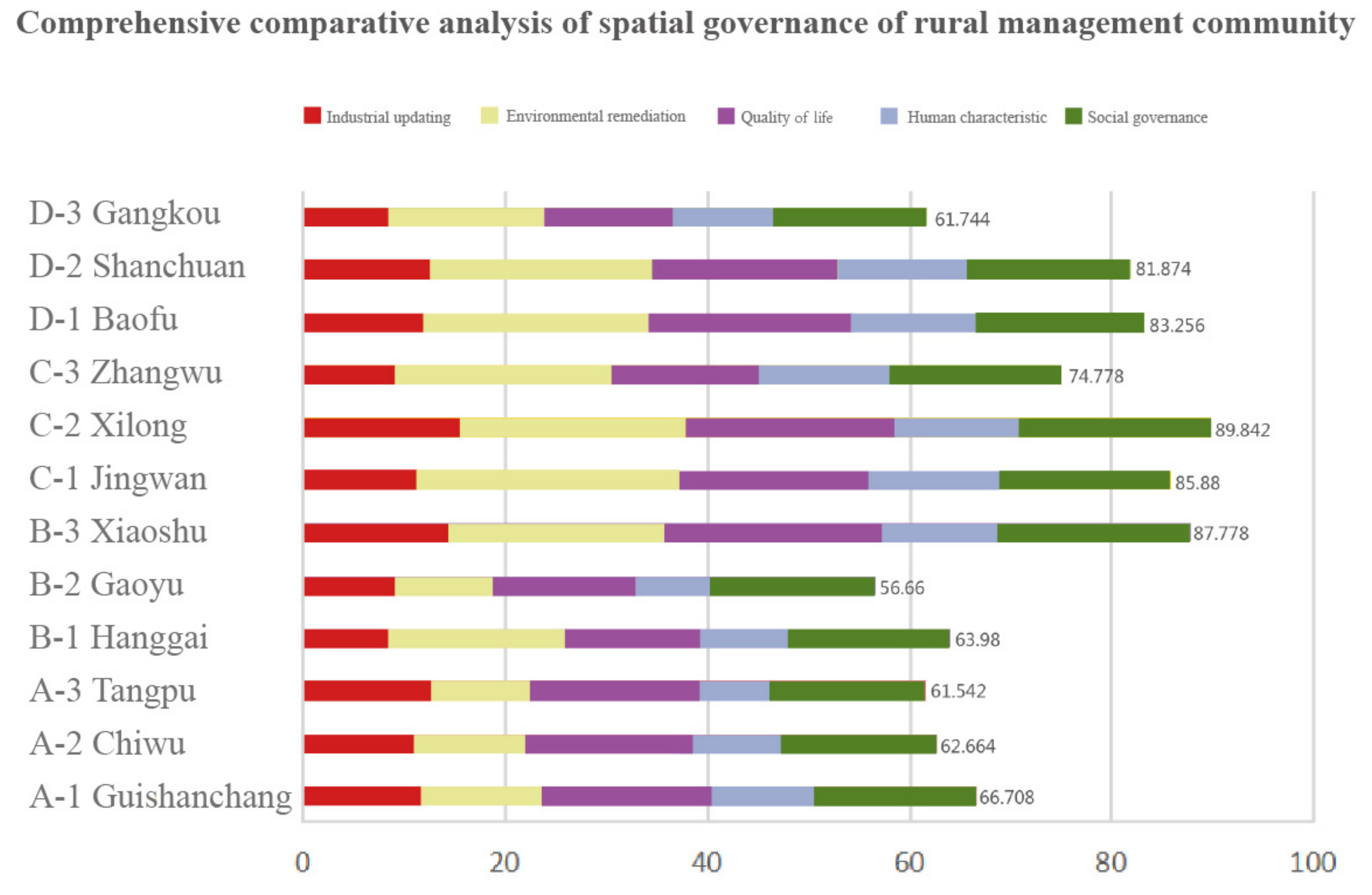
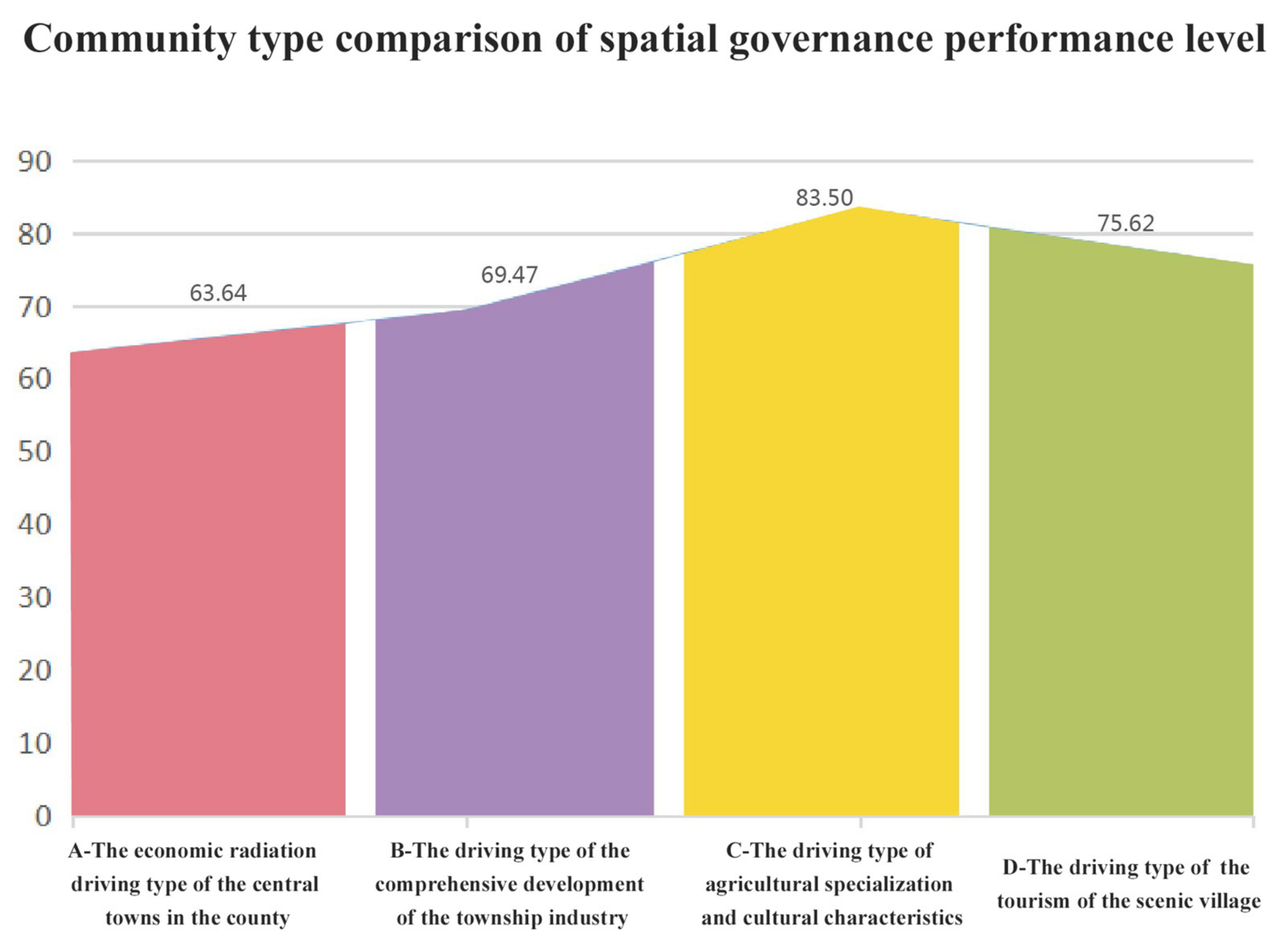
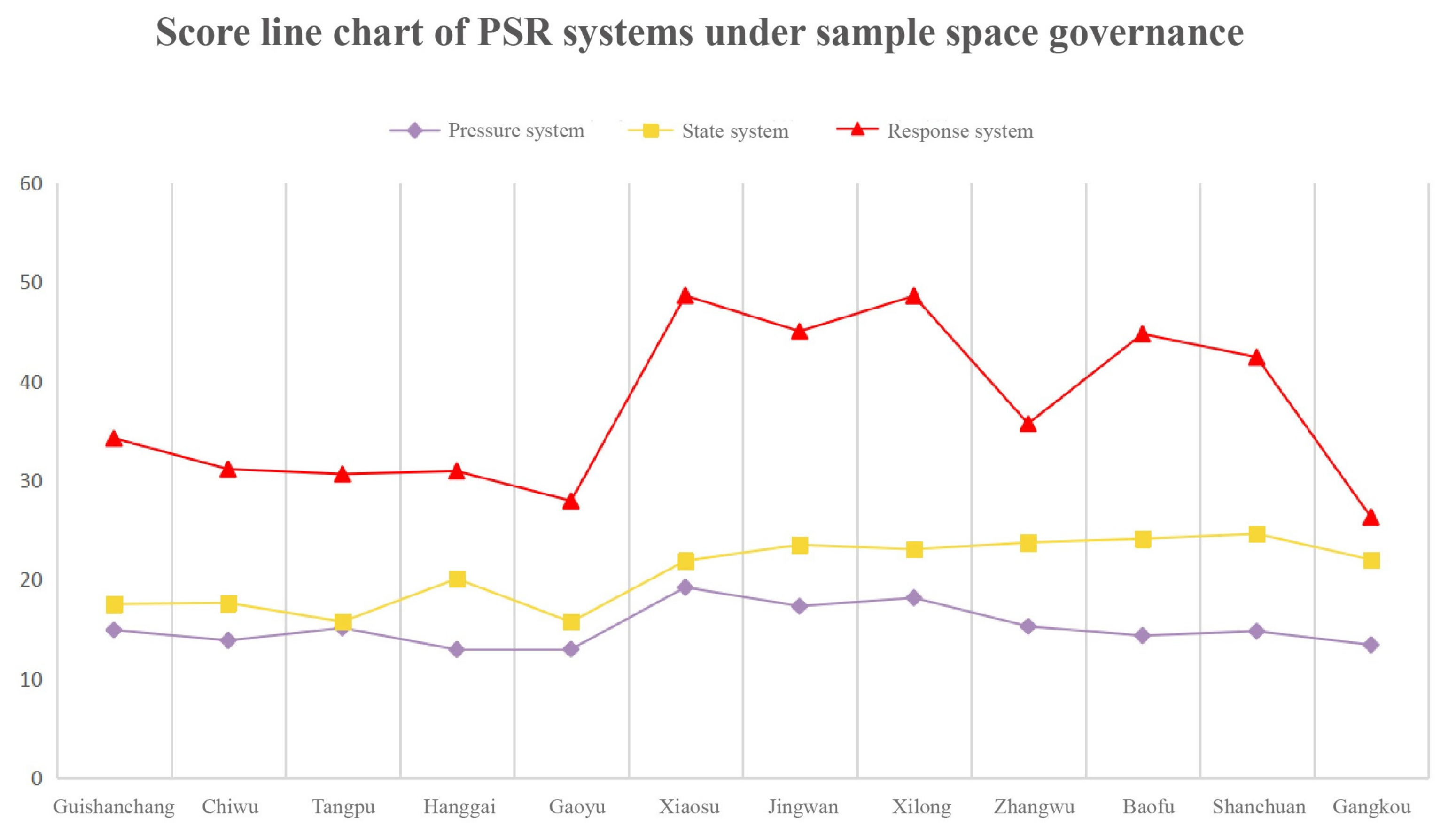
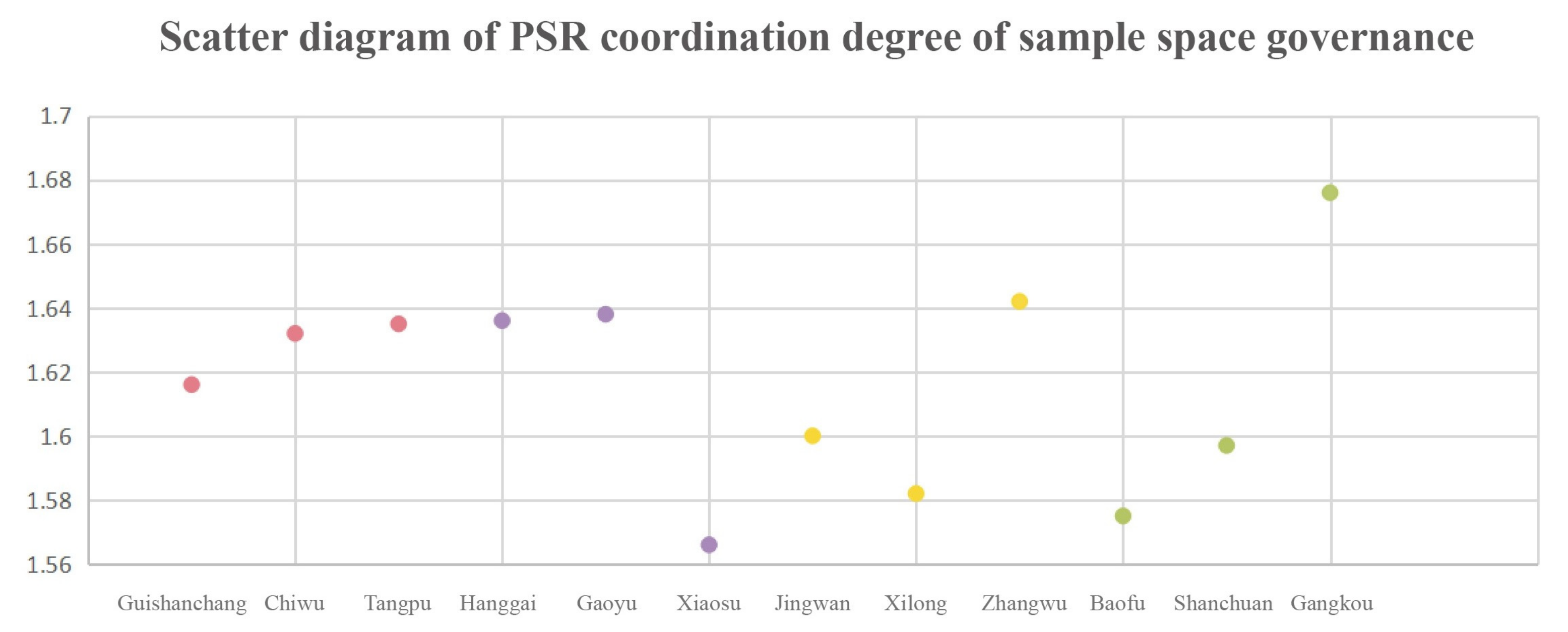
| Time | Region | Governance Policy Action | Specific Measures |
|---|---|---|---|
| 1950s | England | Settlements of in the center of villages and towns | Long-term renewal goals for village and town communities were set; the existing settlements for villages and towns were classified, and different planning policies were mapped out to guide differently. Planning methods were adopted to control the disorderly construction of residential and production buildings. |
| 1960s | Germany | Renewal plan for village and town communities. | Local features were preserved, and traditional buildings were renewed. Rural characteristics were protected, and infrastructure in villages and towns was expanded. The ecosystem was preserved, the villages and towns and their surroundings were coordinated; the economy of the villages and towns was developed according to the local conditions. |
| 1970s | Korea | “New village campaign” | Material, financial, and technical support was provided to villagers free of charge. Training institutions were established to train the backbone personnel for the “New Village Campaign”. Measures and rules for the construction of individual village and town communities were made. |
| 1970s | Japan | “Village building campaign” | The gap between urban and rural construction of living environment facilities was narrowed. Local resources were fully used. Communities with regional characteristics were built in village and town communities; residents participated in management, etc. |
| 21st Century | China | “Rural revitalization” | Integrated development of urban and rural areas and harmonious coexistence of human beings and nature were pursued. Relevant measures were adjusted according to local conditions, and gradual progress was ensured. Structural reform on the supply side of agriculture was promoted. The innovative development of agriculture, forestry, animal husbandry, fishery, and seed industry was promoted. The overall development of rural undertakings was advanced. The improvement was made in water supply, power supply, information, and other infrastructure. Steady efforts were made to carry out rural living environmental renovation actions. |
| Time | Scholars | Main Contents |
|---|---|---|
| 1988 | Everett Rogers and Raber Burdge [34] | “The Transformation of Communities of Villages”, an exhaustive study is conducted on the transformation and development of governance of village and town communities from the perspective of the territorial structure of these communities. |
| 1998 | Marsden et al. [35] | All states participate in governance in a bid to develop the economy of village and town communities. Thus, the vitality of the community can be further triggered, and meanwhile, the local ecological resources and humanistic characteristics are preserved and maintained well. |
| 2008 | Ye [36] | It is found from the practical experience of community governance in villages and towns of different countries that different countries have taken different approaches to governance policies. |
| 2010 | Ferdinand Tennies [37] | Points out that there are three types of community governance: families; rural areas, and small cities. Different government scopes, and a process of gradual upgrading are demonstrated here. |
| 2013 | Torre et al. [38] | Emerging rural activities will benefit rural spatial governance and that innovation in rural development is the multi-level, and multi-faceted one. |
| 2016 | Westerink [39] | Provides a new classification of spatial governance by boundary theory (institutional boundaries, social boundaries, and spatial boundaries). |
| 2017 | Agyemang [40] | Initially used spatial mapping of the urban-rural population continuum, transportation networks, built-up patterns, and GIS technology to depict urbanized areas, thus improving the existing spatial governance framework. |
| 2018 | Sielker [41] | The spatial governance is divided into three parts: policy, financial instruments and institutional instruments, all of which interact with each other. |
| 2018 | Asher et al. [42] | The “administratively remote” spatial organization is not conducive to public service and economic development, with all villages in India as samples. |
| 2020 | Ge et al. [43] | Land use transformation should be an important feature of rural transformational development, as well as a basis for rural spatial governance. |
| 2021 | Sun et al. [44] | Constructing a multi-scale governance system of “event-organization-ownership” to improve the implementation path of existing rural spatial governance. |
| No. | Name of Village and Town Communities | Town | Number of Households/Total Population (Households/Person) | Land Area (km2) | GDP per Capita (2018) | Proportion of Tertiary Industry in GDP (2018) | Greening Coverage Rate of Built-Up Area |
|---|---|---|---|---|---|---|---|
| 1 | Tangpu Community | Dipu Subdistrict | 486/1365 | 2 | 79,540 | 24.6% | 41.5% |
| 2 | Chiwu Village | Xiaofeng Town | 826/2760 | 18 | 59,473 | 53.6% | 46.2% |
| 3 | Guishanchang Village | Xiaoyuan Subdistrict | 901/3078 | 15 | 71,624 | 36.2% | 43.7% |
| 4 | Zhangwu Village | Zhangwu Town | 711/2432 | 12 | 31,322 | 68.9% | 61.5% |
| 5 | Xilong Village Group | Xilong Town | 726/2702 | 14 | 85,501 | 33.5% | 64.2% |
| 6 | Jingwan Village | Meixi Town | 680/2865 | 5 | 54,978 | 43.7% | 66.1% |
| 7 | Gaoyu Village | Tianzihu Town | 1518/5558 | 16 | 69,744 | 38.6% | 44.9% |
| 8 | Xiaoshu Community Group | Meixi Town | 2500/8600 | 15 | 64,978 | 44.3% | 65.7% |
| 9 | Hanggai Village | Hanggai Town | 876/3008 | 13 | 32,421 | 41.2% | 62.8% |
| 10 | Port Village | Tianhuangping Town | 813/2872 | 12 | 40,332 | 49.1% | 61.4% |
| 11 | Baofu Village | Baofu Town | 874/2650 | 10 | 41,429 | 57.4% | 69.2% |
| 12 | Shanchuan Village | Shanchuan Town | 403/1400 | 4 | 52,144 | 61.2% | 65.7% |
| Dimension | Pressure | State | Response | |
|---|---|---|---|---|
| Components | ||||
| Industrial upgrading | Economic density, retail sales of per capita social consumer goods, etc. | The proportion of output of each industry in GDP, industry coordination, etc. | Rectification of existing inadequate industries; adjustment of industrial structure; optimization of business environment; cultivation of new businesses. | |
| Environmental renovation | Energy consumption per unit of GDP, ecological land fragmentation, etc. | Emissions of waste gas and wastewater per sq.km.; water quality of rivers and lakes. | Environmental improvement is deepened in a comprehensive manner; a modern transportation network is built; clean energy is used. | |
| Life quality | Residential per capita land area; quality of built-up residential area. | Public green space per capita public green space area in built-up areas, indoor and outdoor cultural and sports facilities per capita. | The trade, culture and sports, learning and living, medical and health facilities are improved; the organic renewal is promoted for historical heritages, old communities, and ancient villages. | |
| Humanistic characteristics | Destruction rate of humanistic characteristics. | Characteristic culture and reservation of cultural relics. | The organic renewal is promoted for historical heritages, old communities, and ancient villages. | |
| Social governance | Population density; incidence rate of criminal cases. | Community honor (civilization, peace, good governance, number of established communities in ecological villages), etc. | Improvement is witnessed in digital management and social governance system and capacity building of the town. | |
| Objective Layer | Criterion Layer | Element Layer | Indicator Layer |
|---|---|---|---|
| Sustainable spatial governance of village and town business communities | Industrial upgrading | Pressure |
|
| Status |
| ||
| Response |
| ||
| Environmental improvement | Pressure |
| |
| Status |
| ||
| Response |
| ||
| Life quality | Pressure |
| |
| Status |
| ||
| Response |
| ||
| Humanistic characteristics | Pressure |
| |
| Status |
| ||
| Response |
| ||
| Social governance | Pressure |
| |
| Status |
| ||
| Response |
|
| Indicator Name | Opinion Concentration | Opinion Coordination | Indicator Name | Opinion Concentration | Opinion Coordination |
|---|---|---|---|---|---|
| 7.5 | 0.19 |
| 7.75 | 0.153 |
| 7.25 | 0.18 |
| 8 | 0.134 |
| 8 | 0.134 |
| 8.25 | 0.113 |
| 6.75 | 0.294 |
| 7.25 | 0.18 |
| 7.5 | 0.19 |
| 8.5 | 0.11 |
| 8.25 | 0.113 |
| 7.25 | 0.18 |
| 5 | 0.302 |
| 7.5 | 0.19 |
| 7.25 | 0.18 |
| 6.75 | 0.28 |
| 7.75 | 0.153 |
| 6.5 | 0.22 |
| 6.5 | 0.22 |
| 8.75 | 0.081 |
| 8.25 | 0.113 |
| 8 | 0.134 |
| 7.5 | 0.19 |
| 7.75 | 0.153 |
| 7.75 | 0.153 |
| 7.25 | 0.18 |
| 8.75 | 0.081 |
| 5.25 | 0.26 |
| 4.25 | 0.499 |
| 7.5 | 0.19 |
| 8 | 0.134 |
| 7.75 | 0.153 |
| 8.25 | 0.113 |
| 5 | 0.302 |
| 8.75 | 0.081 |
| 6.75 | 0.28 |
| 7.5 | 0.19 |
| 7.75 | 0.153 |
| 7.75 | 0.153 |
| 6.5 | 0.22 |
| 5 | 0.302 |
| 8 | 0.134 |
| 4.75 | 0.351 |
| 7.5 | 0.19 |
| 8 | 0.134 |
| 8.25 | 0.113 |
| 6.5 | 0.22 |
| 8 | 0.134 |
| Objective Layer A | Criterion Layer C | Element Layer H | Indicator Layer F |
|---|---|---|---|
| Village and town business communities Evaluation index system of sustainable spatial governance A1 | Industrial upgrading (C1) | Pressure (H1) | Economic density (F1) |
| Retail sales of per capita social consumer goods (F2) | |||
| GDP per capita (F3) | |||
| Status (H2) | Proportion of (output of) tertiary sector in GDP (F4) | ||
| GDP and land elasticity (F5) | |||
| Response (H3) | Remediation rate of “unsafe, disorderly and illegal” enterprises (F6) | ||
| Improvement degree of modern service industry (F7) | |||
| Industry–town integration promotion degree (F8) | |||
| Environmental renovation (C2) | Pressure (H4) | Energy consumption per unit of GDP (F9) | |
| Fragmentation degree of ecological land in built-up area(F10) | |||
| Status (H5) | Rate of reaching standard for water quality of rivers and lakes (F11) | ||
| Waste gas/water emissions per sq. km. (F12) | |||
| Road traffic accessibility in built-up area (F13) | |||
| Response (H6) | Harmless treatment ratio for house refuse (F14) | ||
| Regulation rate of traffic network and municipal facilities (F15) | |||
| Efforts to demolish illegally constructed buildings (F16) | |||
| Perfection of public service facilities layout (F17) | |||
| Life quality (C3) | Pressure (H7) | Per capita land area (F18) | |
| Per capita indoor and outdoor sports facilities (F19) | |||
| Status (H8) | Public green space per capita in built-up area (F20) | ||
| Green coverage rate of built district (F21) | |||
| Response (H9) | Housing supply quality improvement rate (F22) | ||
| Perfection of medical style facilities construction in business school (F23) | |||
| Innovation and application of construction technology (F24) | |||
| Improvement of public travel sharing system (F25) | |||
| Humanistic characteristics (C4) | Status (H10) | Characteristic culture and reservation of cultural relics (F26) | |
| Response (H11) | Number of traditional village cultural heritage protection construction (F27) | ||
| Number of organically renewed old neighborhoods (F28) | |||
| Investment amount of urban image publicity body (F29) | |||
| Social governance or governance of society (C5) | Pressure (H12) | Population density (F30) | |
| Incidence of criminal cases (F31) | |||
| Status(H13) | Community honor acquirement index (F32) | ||
| Response (H14) | Perfection of long-term intelligent management mechanism (F33) | ||
| Citizen literacy promotion degree (F34) | |||
| Government service ability (F35) | |||
| Improvement of social governance system construction (F36) |
| Criterion Layer C | Weight | Element Layer H | Weight | Indicator Layer F | Weights |
|---|---|---|---|---|---|
| Industrial upgrading (C1) | 0.2014 | Pressure (H1) | 0.0627 | Economic density (F1) | 0.0218 |
| Retail sales of per capita social consumer goods (F2) | 0.0161 | ||||
| GDP per capita (F3) | 0.0248 | ||||
| Status (H2) | 0.0416 | Proportion of (output of) tertiary sector in GDP (F4) | 0.0251 | ||
| GDP and land elasticity (F5) | 0.0165 | ||||
| Response (H3) | 0.0971 | Remediation rate of “unsafe, disorderly and illegal” enterprises (F6) | 0.0381 | ||
| Improvement degree of modern service industry (F7) | 0.0303 | ||||
| Industry–town integration promotion degree (F8) | 0.0287 | ||||
| Environmental renovation (C2) | 0.2431 | Pressure (H4) | 0.0520 | Energy consumption per unit of GDP (F9) | 0.0296 |
| Fragmentation degree of ecological land in built-up area (F10) | 0.0224 | ||||
| Status (H5) | 0.0664 | Rate of reaching standard for water quality of rivers and lakes (F11) | 0.0210 | ||
| Waste gas/water emissions per sq.km. (F12) | 0.0234 | ||||
| Road traffic accessibility in built-up area (F13) | 0.0220 | ||||
| Response (H6) | 0.1247 | Harmless treatment ratio for house refuse (F14) | 0.0395 | ||
| Regulation rate of traffic network and municipal facilities (F15) | 0.0384 | ||||
| Efforts to demolish illegally constructed buildings (F16) | 0.0274 | ||||
| Perfection of public service facilities layout (F17) | 0.0194 | ||||
| Life quality (C3) | 0.2187 | Pressure (H7) | 0.0546 | Per capita land area (F18) | 0.0258 |
| Per capita indoor and outdoor sports facilities (F19) | 0.0288 | ||||
| Status (H8) | 0.0563 | Public green space per capita in built-up area (F20) | 0.0299 | ||
| Green coverage rate of built district (F21) | 0.0264 | ||||
| Response (H9) | 0.1078 | Housing supply quality improvement rate (F22) | 0.0234 | ||
| Perfection of medical style facilities construction in business school (F23) | 0.0488 | ||||
| Innovation and application of construction technology (F24) | 0.0098 | ||||
| Improvement of public travel sharing system (F25) | 0.0258 | ||||
| Humanistic characteristics(C4) | 0.1431 | Status (H10) | 0.0347 | Characteristic culture and reservation of cultural relics (F26) | 0.0347 |
| Response (H11) | 0.1084 | Number of traditional village cultural heritage protection construction (F27) | 0.0440 | ||
| Number of organically renewed old neighborhoods (F28) | 0.0366 | ||||
| Investment amount of urban image publicity body (F29) | 0.0278 | ||||
| Governance of society (C5) | 0.1937 | Pressure (H12) | 0.0413 | Population density (F30) | 0.0185 |
| Incidence of civil criminal cases (F31) | 0.0228 | ||||
| Status (H13) | 0.0583 | Community honor acquirement index (F32) | 0.0583 | ||
| Response (H14) | 0.0941 | Perfection of long-term intelligent management mechanism (F33) | 0.0334 | ||
| Citizen literacy promotion degree (F34) | 0.0139 | ||||
| Government service ability (F35) | 0.0278 | ||||
| Enhancement degree of social governance system (F36) | 0.0190 |
| Evaluation Indicator | Evaluation Criteria | ||||
|---|---|---|---|---|---|
| 100 | 80 | 60 | 40 | 20 | |
| (F1) Economic density (10 thousand yuan/sq.) | Above 2500 | 2000–2500 | 1500–2000 | 1000–1500 | 1000 or less |
| (F2) Retail sales of per capita social consumer goods (10 thousand yuan/sq.km.) | Above 1500 | 1200–1500 | 900–1200 | 600–900 | 600 or more |
| (F3) GDP per capita (yuan/person.) | 80,000 or more | 60–80,000 | 40–60,000 | 20–40,000 | Less than 20,000 |
| (F4) Proportion of (output of) tertiary sector in GDP | 60% or more | 50–60% | 40–50% | 30–40% | Less than 30% |
| (F5) GDP and land elasticity | Above 10 | 8–10 | 6–8 | 4–6 | Below 4 |
| (F6) Investment for remediation of “unsafe, disorderly and illegal” enterprises (10 thousand yuan) | More than 3000 | 2000–3000 | 1500–2000 | 1000–1500 | 1000 or less |
| (F7) Industry–town integration promotion degree | Township storage parks are newly built; distribution and other logistics services are improved; the coverage rate of rural e-commerce service stores in administrative villages is scored and arranged according to the township departmental standing book. | ||||
| (F8) Industry–town integration promotion degree | Experts and government officials are invited to score and arrange the degree according to the interaction and integration of industries and towns on basis of the industrial positioning and leading industry’s promotion of interaction, integrity and agglomeration of industry and town. | ||||
| (F9) Energy consumption per unit of GDP | Below 0.01 | 0.01–0.1 | 0.1–0.2 | 0.2–0.3 | Above 0.3 |
| (F10) Fragmentation degree of ecological land in built-up area | Based on relevant government indexes, experts and sub-government officials are invited to score and arrange the fragmentation. | ||||
| (F11) Rate of reaching standard for water quality of rivers and lakes | 100% | Above 95% | 90–95% | 85–90% | 80–85% |
| (F12) Waste gas/water emissions per sq.km. | Index data are compiled based on the assessment of the Environmental Protection Bureau. | ||||
| (F13) Road traffic accessibility in built-up area | Indicator data are compiled according to the assessment of the Traffic Management Bureau. | ||||
| (F14) Harmless treatment ratio for house refuse | Index data are compiled based on the assessment of Environmental Protection Bureau. | ||||
| (F15) Regulation rate of traffic network and municipal facilities | Above 50 million | 3500–5000 | 2500–3500 | 1000–2500 | Below 1000 |
| (F16) Efforts to demolish illegally constructed buildings | Above 40 | 30–40 | 20–30 | 10–20 | Below 10 |
| (F17) Perfection of public service facilities layout | More than 10 | 8–10 | 6–8 | 4–6 | Less than 4 |
| (F18) Per capita land area | More than 50 | 35–50 | 25–35 | 15–25 | Less than 15 |
| (F19) Per capita indoor and outdoor sports facilities (m2/person) | More than 15 | 12–15 | 9–12 | 6–9 | Less than 6 |
| (F20) Per capita public green space area in built–up area (m2/person) | More than 35 | 30–35 | 25–30 | 20–25 | 20 |
| (F21) Green coverage rate of built district | More than 60 | 50–60 | 40–50 | 30–40 | Less than 30 |
| (F22) Housing supply quality improvement rate | Very high | High | Moderate | Low | Very low |
| (F23) Perfection of medical style facilities construction in business school | Very high | High | Moderate | Low | Very low |
| (F24) Innovation and application of construction technology | More than 5 | 4 | 3 | 2 | 1 |
| (F25) Improvement of public travel sharing system | More than 10 | 8–10 | 6–8 | 4–6 | Less than 4 |
| (F26) Characteristic culture and reservation of cultural relics | Very high | High | Moderate | Low | Very low |
| (F27) Number of traditional village cultural heritage protection construction | More than 10 million | 800–1000 | 600–800 | 400–600 | Below 400 |
| (F28) Number of organically renewed old neighborhoods | More than 5 | 4 | 3 | 2 | 1 |
| (F29) Investment amount of urban image publicity body | More than 10 million | 800–1000 | 600–800 | 400–600 | Less than 400 |
| (F30) Population density (person/sq.km.) | More than 300 | 250–300 | 200–250 | 150–200 | Less than 150 |
| (F31) Incidence of criminal cases | No occurrence | 1–2 | 2–4 | 4–6 | More than 6 |
| (F32) Community honor acquirement index | More than 5 | 4 | 3 | 2 | 1 |
| (F33) Perfection of long-term intelligent management mechanism | Very high | High | Moderate | Low | Very low |
| (F34) Citizen literacy promotion degree | See the Glossary of Index Terms | ||||
| (F35) Government service ability | Very strong | Strong | Moderate | Weak | Very weak |
| (F36) Improvement of social governance system construction | Very high | High | Moderate | Low | Very low |
| Grade | Spatial Governance of Village and Town Communities | |||
|---|---|---|---|---|
| Grade I | Grade Ⅱ | Grade III | Grade IV | |
| Score | 100–85 | 84–75 | 74–65 | 64–0 |
| Indicator Factor | Score of Each Sample Community | |||||||||||
|---|---|---|---|---|---|---|---|---|---|---|---|---|
| A-1 Guishanchang | A-2 Chibu | A-3 Tongpu | B-1 Hangai | B-2 Gaoyu | B-3 Xiaoshu | C-1 Jingwan | C-2 Xilong | C-2 Zhangwu | D-1 Baofu | D-2 Shanchuan | D-3 Port | |
| F1 | 80 | 40 | 80 | 20 | 60 | 60 | 60 | 100 | 20 | 20 | 20 | 40 |
| F2 | 80 | 60 | 100 | 20 | 60 | 80 | 60 | 80 | 60 | 40 | 40 | 40 |
| F3 | 80 | 80 | 100 | 40 | 80 | 80 | 40 | 100 | 40 | 40 | 40 | 40 |
| F4 | 40 | 80 | 20 | 60 | 40 | 60 | 60 | 40 | 100 | 80 | 100 | 60 |
| F5 | 80 | 80 | 100 | 40 | 60 | 80 | 80 | 100 | 60 | 60 | 60 | 60 |
| F6 | 40 | 40 | 20 | 40 | 20 | 80 | 20 | 60 | 40 | 60 | 40 | 20 |
| F7 | 60 | 40 | 60 | 40 | 40 | 100 | 100 | 100 | 20 | 80 | 80 | 20 |
| F8 | 60 | 40 | 100 | 60 | 60 | 80 | 80 | 100 | 60 | 80 | 100 | 80 |
| F9 | 60 | 80 | 20 | 100 | 20 | 60 | 100 | 60 | 100 | 100 | 100 | 80 |
| F10 | 60 | 40 | 60 | 80 | 60 | 80 | 100 | 80 | 100 | 80 | 100 | 80 |
| F11 | 80 | 80 | 60 | 100 | 60 | 80 | 100 | 100 | 100 | 100 | 100 | 100 |
| F12 | 20 | 40 | 20 | 60 | 20 | 60 | 100 | 80 | 100 | 100 | 100 | 100 |
| F13 | 80 | 40 | 80 | 40 | 60 | 80 | 60 | 100 | 40 | 80 | 80 | 60 |
| F14 | 60 | 40 | 60 | 60 | 40 | 100 | 100 | 80 | 60 | 100 | 100 | 80 |
| F15 | 20 | 20 | 20 | 100 | 40 | 100 | 100 | 100 | 100 | 80 | 80 | 20 |
| F16 | 40 | 40 | 20 | 40 | 40 | 100 | 100 | 100 | 40 | 80 | 80 | 20 |
| F17 | 60 | 40 | 40 | 80 | 20 | 100 | 100 | 100 | 80 | 80 | 80 | 40 |
| F18 | 60 | 60 | 60 | 80 | 60 | 80 | 100 | 100 | 100 | 100 | 100 | 100 |
| F19 | 80 | 80 | 100 | 60 | 80 | 100 | 100 | 80 | 60 | 80 | 80 | 40 |
| F20 | 60 | 60 | 60 | 100 | 40 | 100 | 100 | 100 | 100 | 100 | 100 | 100 |
| F21 | 60 | 60 | 60 | 100 | 60 | 100 | 100 | 100 | 100 | 100 | 100 | 100 |
| F22 | 100 | 80 | 100 | 20 | 80 | 100 | 60 | 80 | 20 | 100 | 80 | 40 |
| F23 | 80 | 80 | 80 | 40 | 60 | 100 | 80 | 100 | 40 | 80 | 60 | 20 |
| F24 | 60 | 60 | 80 | 80 | 60 | 100 | 80 | 80 | 60 | 80 | 100 | 60 |
| F25 | 60 | 60 | 80 | 40 | 80 | 100 | 60 | 100 | 60 | 80 | 60 | 40 |
| F26 | 60 | 80 | 60 | 60 | 60 | 80 | 100 | 80 | 100 | 100 | 100 | 100 |
| F27 | 60 | 60 | 20 | 60 | 20 | 60 | 100 | 80 | 100 | 80 | 80 | 60 |
| F28 | 80 | 60 | 40 | 20 | 40 | 60 | 80 | 80 | 80 | 60 | 60 | 40 |
| F29 | 60 | 80 | 40 | 80 | 60 | 100 | 100 | 100 | 100 | 100 | 100 | 80 |
| F30 | 60 | 60 | 60 | 20 | 60 | 100 | 60 | 80 | 60 | 20 | 20 | 40 |
| F31 | 80 | 80 | 80 | 100 | 80 | 100 | 100 | 100 | 100 | 100 | 100 | 100 |
| F32 | 100 | 80 | 80 | 100 | 100 | 100 | 100 | 100 | 100 | 100 | 100 | 80 |
| F33 | 80 | 60 | 80 | 60 | 80 | 100 | 80 | 100 | 80 | 100 | 100 | 80 |
| F34 | 100 | 100 | 100 | 80 | 100 | 100 | 100 | 100 | 100 | 100 | 100 | 80 |
| F35 | 80 | 100 | 80 | 100 | 80 | 100 | 100 | 100 | 100 | 100 | 100 | 80 |
| F36 | 100 | 100 | 100 | 100 | 100 | 100 | 100 | 100 | 80 | 100 | 80 | 80 |
| Type | Samples of Villages and Towns | Industrial Upgrading | Environmental Renovation | Life Quality | Humanistic Characteristics | Governance of Society | Weighted Composite Score |
|---|---|---|---|---|---|---|---|
| A—the economic radiation-driven type of central towns in county | A-1 Guishanchang | 12.404 | 12.426 | 15.61 | 9.318 | 16.95 | 66.708 |
| A-2 Chiwu | 11.034 | 10.98 | 15.142 | 9.836 | 15.672 | 62.664 | |
| A-3 Tangpu | 13.436 | 9.886 | 16.898 | 5.538 | 15.784 | 61.542 | |
| B—the comprehensive development of township industry | B-1 Hangai | 8.374 | 17.994 | 13.658 | 7.678 | 16.276 | 63.98 |
| B-2 Gaoyu | 9.948 | 9.584 | 14.084 | 6.094 | 16.95 | 56.66 | |
| B-3 Xiaoshu | 15.78 | 20.882 | 21.354 | 10.392 | 19.37 | 87.778 | |
| C—the characteristic-driven agricultural specialized production | C-1 Jingwan | 12.18 | 23.43 | 18.73 | 13.578 | 17.962 | 85.88 |
| C-2 Xilong | 16.788 | 21.42 | 20.63 | 12.004 | 19 | 89.842 | |
| C-2 Zhangwu | 9.746 | 19.378 | 14.494 | 13.578 | 17.582 | 74.778 | |
| D—the tourism industry driving type of scenic village | D-1 Baofu | 12.076 | 21.718 | 19.606 | 11.966 | 17.89 | 83.256 |
| D-2 Shanchuan | 12.39 | 22.166 | 17.842 | 11.966 | 17.51 | 81.874 | |
| D-3 Port | 8.668 | 15.172 | 12.894 | 9.798 | 15.212 | 61.744 |
| Type | Village and Town Sample | Pressure System | State System | Response System | Coordination(C) |
|---|---|---|---|---|---|
| A—the economic radiation-driven type of central towns in county | A-1 Guishanchang | 14.922 | 17.522 | 34.264 | 1.616 |
| A-2 Chibu | 13.872 | 17.642 | 31.15 | 1.632 | |
| A-3 Tangpu | 15.132 | 15.764 | 30.646 | 1.635 | |
| B—the comprehensive development of township industry | B-1 Hangai | 12.944 | 20.092 | 30.944 | 1.636 |
| B-2 Gaoyu | 12.98 | 15.734 | 27.946 | 1.638 | |
| B-3 Xiaoshu | 19.222 | 21.906 | 48.65 | 1.566 | |
| C—the characteristic-driven agricultural specialized production | C-1 Jingwan | 17.316 | 23.516 | 45.048 | 1.600 |
| C-2 Xilong | 18.16 | 23.062 | 48.62 | 1.582 | |
| C-2 Zhangwu | 15.292 | 23.75 | 35.736 | 1.642 | |
| D—the tourism industry driving type of scenic village | D-1 Baofu | 14.358 | 24.128 | 44.77 | 1.575 |
| D-2 Shanchuan | 14.806 | 24.63 | 42.438 | 1.597 | |
| D-3 Port | 13.42 | 22.02 | 26.304 | 1.676 |
Publisher’s Note: MDPI stays neutral with regard to jurisdictional claims in published maps and institutional affiliations. |
© 2022 by the authors. Licensee MDPI, Basel, Switzerland. This article is an open access article distributed under the terms and conditions of the Creative Commons Attribution (CC BY) license (https://creativecommons.org/licenses/by/4.0/).
Share and Cite
Zhu, X.; Shi, H.; Li, Z.; Zhong, Y.; Zhu, K. The Study on the Performance Evaluation of Spatial Governance of Village and Town Business Communities. Systems 2022, 10, 109. https://doi.org/10.3390/systems10040109
Zhu X, Shi H, Li Z, Zhong Y, Zhu K. The Study on the Performance Evaluation of Spatial Governance of Village and Town Business Communities. Systems. 2022; 10(4):109. https://doi.org/10.3390/systems10040109
Chicago/Turabian StyleZhu, Xiaoqing, Hanyuan Shi, Zhixing Li, Yuebin Zhong, and Kening Zhu. 2022. "The Study on the Performance Evaluation of Spatial Governance of Village and Town Business Communities" Systems 10, no. 4: 109. https://doi.org/10.3390/systems10040109






